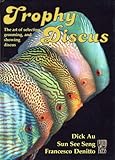
 The Capital Cichlid Association was back after their summer break on Saturday with a huge meeting, featuring Dick Au, author and expert on discus. With many cichlid-o-philes from all
The Capital Cichlid Association was back after their summer break on Saturday with a huge meeting, featuring Dick Au, author and expert on discus. With many cichlid-o-philes from all
over the east coast region attending, there were at least 84 people in attendance. This month also had the largest auction I’ve ever seen at one of their meetings.
Dick Au gave a fantastic talk, dumbing down the basics of keeping Discus, so that I left that meeting feeling like they might not be as much trouble as their reputation suggests. He went through the entire lifecycle of how to choose your discus, who to buy them from, how to keep them, breed them, raise the fry, and so on. He stressed that the most important thing whenever keeping discus is to make sure you get quality discus from the start, otherwise, you’re just asking for trouble down the line. He suggested avoiding chain or general purpose pet stores, but fish stores who maintain significant stock of discus year-round should be okay because they need to know how to care for them to keep their stock healthy.
 Even so, he suggests that you always ask the store owner to feed them in the store before buying, so that you can make sure they have a good apetite. Without that, there’s likely something wrong with them. Of course, breeders of discus who maintain quality strains are great sources as well.
Even so, he suggests that you always ask the store owner to feed them in the store before buying, so that you can make sure they have a good apetite. Without that, there’s likely something wrong with them. Of course, breeders of discus who maintain quality strains are great sources as well.
One of the things that he mentioned which surprised me was that he didn’t neccessarily recommend keeping them in planted tanks. Not that it can’t be done well, but he said it’s much harder to maintain proper water quality without being able to vacuum up uneaten food, like you can in a bare-bottom tank.
That said, Dick did mention that discus have been raised in captivity long enough that most are quite adaptable to a wide range of water conditions, contrary to their wild counterparts. As long as your water doesn’t have significantly high pH, he recommends using tap water for water changes, verses mixing your own RO water because he believes the water conditions stay more stable that way. Additionally, while temperatures between 80 and 84 degrees are ideal, most discus will do just fine in slightly lower or slight warmer temps. This is good if you do want to keep them with plants. He discused far many more topics, but most of them are covered in detail in his two books.
Overall, this was a fantastic meeting!
 On Saturday, GWAPA had another packed meeting at Kevin’s house in Silver Spring, MD. This month, over thirty folks showed up to hear about soil substrates in the planted aquarium. One of our members, Sean, is the originator of the soil substrate recipe that so many people are starting to use in the hobby. It was popularized by AaronT and others on Aquatic Plant Central, and we got to hear the soil method straight from the source.
On Saturday, GWAPA had another packed meeting at Kevin’s house in Silver Spring, MD. This month, over thirty folks showed up to hear about soil substrates in the planted aquarium. One of our members, Sean, is the originator of the soil substrate recipe that so many people are starting to use in the hobby. It was popularized by AaronT and others on Aquatic Plant Central, and we got to hear the soil method straight from the source.



















